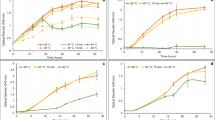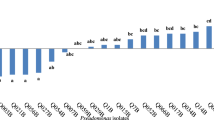Abstract
Three plant growth-promoting rhizobacteria strains containing ACC-deaminase (Pseudomonas jessenii, Pseudomonas fragi, and Serratia fonticola) and Rhizobium leguminosarum were selected and characterized by conducting some experiments under axenic condition. The selected isolates had the potential to improve the growth of lentil seedlings under axenic conditions. Pot and field experiments were conducted to evaluate the potential of these selected strains for improving growth and yield of lentil under natural conditions. A classical triple response (reduction of stem elongation, swelling of hypocotyle, and change in the direction of growth) bioassay was also conducted to evaluate the effect of high ethylene concentration on the growth of etiolated lentil seedlings, and the performance of coinoculation was evaluated to reduce the classical triple response in comparison with cobalt (Co2+), a chemical inhibitor of ethylene. Results showed that coinoculation of Pseudomonas and Serratia sp. with R. leguminosarum significantly increased the growth and yield of lentil. However, synergistic/coinoculation effect of P. jessenii with R. leguminosarum was more pronounced compared to that with P. fragi and S. fonticola. It increased the number of pods per plant, number of nodules per plant, dry nodule weight, grain yield, and straw yield up to 76%, 196%, 109%, 150%, and 164% under pot and up to 98%, 98%, 100%, 82%, and 78%, respectively, under field conditions as compared to uninoculated control. Similarly, combined inoculation significantly increased N concentration of grains under both pot and field conditions. The results from classical triple response assay showed that the effects of classical triple response decreased due to coinoculation in etiolated lentil seedlings and due to a decrease in the ethylene concentration. It is suggested that the strategy adopted by Pseudomonas sp. containing ACC-deaminase with Rhizobium to promote nodulation and yield by adjusting ethylene levels could be exploited as an effective tool for improving growth, nodulation, and yield of lentil.

Similar content being viewed by others
References
Abeles FD, Morgan PW, Saltveit ME Jr (1992) Ethylene in plant biology, 2nd edn. Academic, San Diego, CA
Arshad M, Frankenberger WT Jr (1993) Microbial production of plant growth regulators. In: Metting FB Jr (ed) Soil microbial ecology. Marcel Dekker, New York, pp 307–347
Arshad M, Frankenberger WT Jr (2002) Ethylene: agricultural sources and applications. Kluwer Academic Publishers, New York, USA
Chebotar VK, Asis CA Jr, Akao S (2001) Production of growth-promoting substances and high colonization ability of rhizobacteria enhance the nitrogen fixation of soybean when coinoculated with Bradyrhizobium japonicum. Biol Fertil Soils 34:427–432
Collavino MM, Sansberro PA, Mroginski LA, Aguilar OM (2010) Comparison of in vitro solubilization activity of diverse phosphate-solubilizing bacteria native to acid soil and their ability to promote Phaseolus vulgaris growth. Biol Fertil Soils 46:727–738
Dworkin M, Foster J (1958) Experiments with some microorganisms which utilize ethane and hydrogen. J Bacteriol 75:592–601
Glick BR (1995) The enhancement of plant growth promotion by free living bacteria. Can J Microbiol 41:109–117
Glick BR, Penrose DM, Li J (1998) A model for lowering plant ethylene concentration by plant growth promoting rhizobacteria. J Theor Biol 190:63–68
Guinazu LB, Andres JA, Del Papa MF, Pistorio M, Rosas SB (2010) Response of alfalfa (Medicago sativa L.) to single and mixed inoculation with phosphate-solubilizing bacteria and Sinorhizobium meliloti. Biol Fertil Soils 46:185–190
Guinel FC, Sloetjes LL (2000) Ethylene is involved in the nodulation phenotype of Pisum sativum R50 (sym16), a pleiotropic mutant that nodulates poorly and has pale green leaves. J Exp Bot 51:88–894
Honma M, Shimomura T (1978) Metabolism of 1-aminocyclopropane-1-carboxylic acid. Agric Biol Chem 42:1825–1831
Kannaiyan S (2002) Biofertilizers for sustainable crop production. In: Kannaiyan S (ed) Biotechnology of biofertilizers. Kluwer Academic Publishers/Narosa Publishing House, New Delhi, India, pp 9–49
Kennedy IR, Pereg-Gerk LL, Wood C, Deaker R, Gilchrist K, Katupitiya S (2004) Biological nitrogen fixation in non-leguminous field crops: facilitating the evolution of an effective association between Azospirillum and wheat. Plant Soil 194:65–79
Kloepper JW, Lifshitz R, Zablotowicz RM (1989) Free-living bacterial inocula for enhancing crop productivity. Trends Biotechnol 7:39–43
Ligero F, Poveda JL, Gresshoff PM, Caba JM (1999) Nitrate inoculation in enhanced ethylene biosynthesis in soybean roots as a possible mediator of nodulation control. J Plant Physiol 154:482–488
Ma JH, Yao JL, Cohen D, Morris B (1998) Ethylene inhibitors enhance in vitro formation from apple shoot culture. Plant Cell Rep 17:211–214
Machackova I, Chavaux N, Dewitte W, Onckelen HV (1997) Diurnal fluctuations in ethylene formation in Chenopodium rubrum. Plant Physiol 113:981–985
Mayak S, Tirosh T, Glick BR (1999) Effect of wild type and mutant plant growth promoting rhizobacteria on the rooting of mung bean cuttings. J Plant Growth Regul 18:49–53
Mehta S, Nautiyal CS (2001) An efficient method for qualitative screening of phosphate solubilizing bacteria. Curr Microbiol 43:57–58
Mirza BS, Mirza MS, Bano A, Malik KA (2007) Coinoculation of chickpea with Rhizobium isolates from roots and nodules and phytohormone-producing Enterobacter strains. Aust J Exp Agric 47:1008–1015
Mishra PK, Mishra S, Selvakumar G, Bisht JK, Kundu S, Gupta HS (2009) Coinoculation of Bacillus thuringeinsis-KR1 with Rhizobium leguminosarum enhances plant growth and nodulation of pea (Pisum sativum L.) and lentil (Lens culinaris L.). World J Microbiol Biotechnol 25:753–761
Nadeem SM, Zahir ZA, Naveed M, Arshad M (2009) Rhizobacteria containing ACC-deaminase confer salt tolerance in maize grown on salt-affected fields. Can J Microbiol 55:1302–1309
Nadeem SM, Zahir ZA, Naveed M, Asghar HN, Arshad M (2010) Rhizobacteria capable of producing ACC-deaminase may mitigate salt stress in wheat. Soil Sci Soc Am J 74:533–542
Parmar N, Dadrawal KR (2003) Stimulation of nitrogen fixation and induction of flavonoid-like compounds by rhizobacteria. J Appl Microbiol 81:229–235
Pathak N, Kalita MK, Barman U, Hazarika BN, Saha NN (2001) Response of summer green gram to inoculation and nitrogen levels in Barak Valley Zone of Assam. Annu Agric Res 22:123–124
Patten CL, Glick BR (1996) Bacterial biosynthesis of indole-3-acetic acid. Can J Microbiol 42:207–220
Plazinski J, Rolfe BG (1985) Influence of Azospirillum strains on nodulation of clovers by Rhizobium strains. Appl Environ Microbiol 49:984–989
Provorov NA, Saimnazarov UB, Bahromov IU, Pulatova DZ, Kozhemyakov AP, Kurbanov GA (1998) Effect of rhizobia inoculation on the seed production of mung bean. J Arid Environ 39:569–575
Reid MS (1995) Ethylene in plant growth, development and senescence. In: Davies PJ (ed) Plant hormone: physiology biochemistry and molecular biology. Kluwer Academic Publishers, Dordrecht, Netherlands, pp 486–508
Remans R, Ramaekers L, Schelkens S, Hernandez G, Garcia A, Reyes JL, Mendez N, Toscano V, Mulling M, Galvez L, Vanderleyden J (2008) Effect of Rhizobium–Azospirillum coinoculation on nitrogen fixation and yield of two contrasting Phaseolus vulgaris L. genotypes cultivated across different environments in Cuba. Plant Soil 312:25–37
Russell AD, Hugo WB, Ayliffo GAJ (1982) Principles and practices of disinfection, preservation and sterilization. Blackwell Science, London
Ryan J, Estefan G, Rashid A (2001) Soil and plant analysis: laboratory manual. International Centre for Agricultural Research in Dry Areas (ICARDA), Aleppo, Syria
Sarwar M, Arshad M, Martens DA, Frankenberger WT Jr (1992) Tryptophan dependent biosynthesis of auxins in soil. Plant Soil 147:207–215
Scervino JM, Mesa MP, Mónica ID, Recchi M, Moreno NS, Godeas A (2010) Soil fungal isolates produce different organic acid patterns involved in phosphate salts solubilization. Biol Fertil Soils 46:755–763
Schmidt JS, Harper JE, Hoffman TK, Bent AF (1999) Regulation of soybean nodulation independent of ethylene signalling. Plant Physiol 119:951–959
Shaharoona B, Arshad M, Zahir ZA (2006a) Effect of plant growth-promoting rhizobacteria containing ACC-deaminase on maize (Zea mays L.) growth under axenic conditions and on nodulation in mung bean (Vigna radiata L.). Lett Appl Microbiol 42:155–159
Shaharoona B, Arshad M, Zahir ZA, Khalid A (2006b) Performance of Pseudomonas spp. containing ACC-deaminase for improving growth and yield of maize (Zea mays L.) in the presence of nitrogenous fertilizers. Soil Biol Biochem 38:2971–2975
Shaharoona B, Arshad M, Khalid M (2007) Differential response of etiolated pea seedlings to inoculation with rhizobacteria capable of utilizing 1-aminocyclopropane-1-carboxylate or L-methionine. J Microbiol 45:15–20
Shahzad SM, Khalid A, Arshad M, Tahir J, Mahmood T (2010) Improving nodulation, growth and yield of Cicer arietinum L. through bacterial ACC-deaminase induced changes in root architecture. Europ J Soil Biol 46:342–347
Simons M, van der Bij AJ, Brand I, de Weger LA, Wijffelman CA, Lugtenberg BJJ (1996) Gnotobiotic system for studying rhizosphere colonization by plant growth-promoting Pseudomonas bacteria. Mol Plant Microb Interact 9:600–607
Steel RGD, Torrie JH, Dicky DA (1997) Principles and procedures of statistics: a biometrical approach, 3rd edn. McGraw Hill Book International Co., Singapore
Tang WH (1994) Yield increasing bacteria (YIB) and biocontrol of sheath blight of rice. In: Ryder MH, Stephens PM, Bowen GD (eds) Improving plant productivity with rhizosphere bacteria. Adelaid, CSIRO, Australia, pp 267–278
Yang SF, Hoffman NE (1984) Ethylene biosynthesis and its regulation in higher plants. Annu Rev Plant Physiol 35:155–189
Yao T (2004) Associative nitrogen-fixing bacteria in the rhizosphere of Avena sativa in an alpine region: III Phosphate-solubilizing power and auxin production. Acta Prataculturae Sin 13:85–90
Zafar-ul-Hye M, Zahir ZA, Shahzad SM, Arshad U, Arshad M (2007a) Isolation and screening of rhizobia for improving growth and nodulation of lentil (Lens culinaris Medic) seedlings under axenic conditions. Soil Environ 26:81–91
Zafar-ul-Hye M, Zahir ZA, Shahzad SM, Naveed M, Arshad M (2007b) Preliminary screening of rhizobacteria containing ACC-deaminase for promoting growth of lentil seedlings under axenic condition. Pak J Bot 39:1725–1738
Acknowledgments
We are thankful to the Higher Education Commission and ALP/PARC for providing financial support.
Author information
Authors and Affiliations
Corresponding author
Rights and permissions
About this article
Cite this article
Zahir, Z.A., Zafar-ul-Hye, M., Sajjad, S. et al. Comparative effectiveness of Pseudomonas and Serratia sp. containing ACC-deaminase for coinoculation with Rhizobium leguminosarum to improve growth, nodulation, and yield of lentil. Biol Fertil Soils 47, 457–465 (2011). https://doi.org/10.1007/s00374-011-0551-7
Received:
Revised:
Accepted:
Published:
Issue Date:
DOI: https://doi.org/10.1007/s00374-011-0551-7




